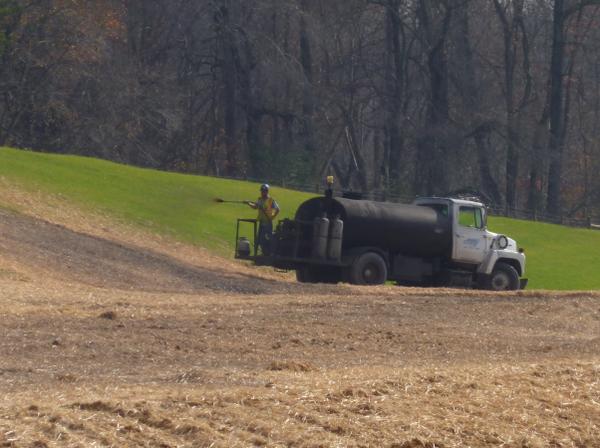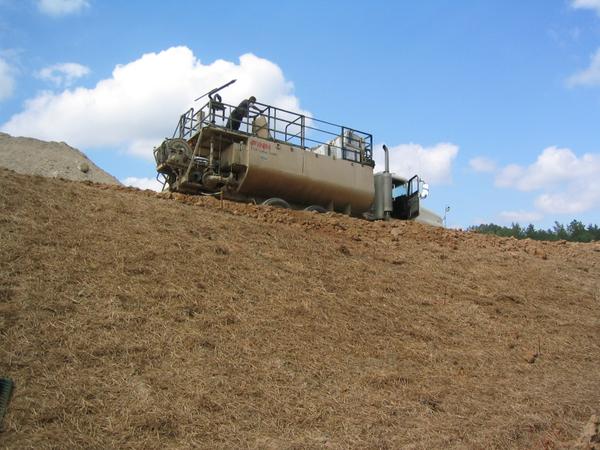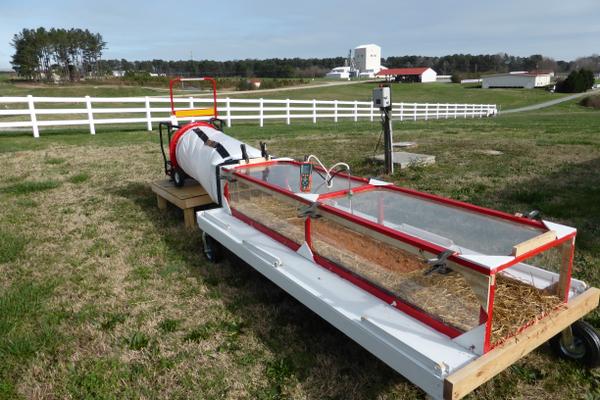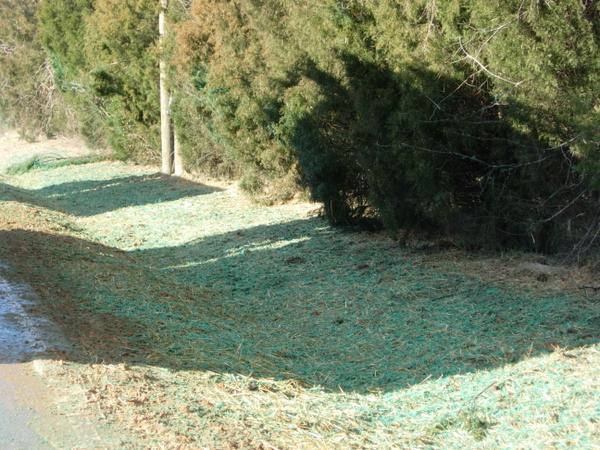Introduction
When land is disturbed by construction, mining, or other development, the bare soil is often stabilized with a vegetative cover such as grass. Grass seeds need a protective mulch to promote germination and growth. Straw is the most widely used mulch, and it has many properties that make it a good choice. However, wind can blow away the straw, so binding agents, commonly known as tackifiers, are applied to hold the straw in place until the grass is established. Asphalt has long been used as a straw tackifier (Figure 1), but recent research has shown that there are a number of alternatives that have several advantages.
The primary reasons for replacing asphalt are the high cost, the need for specialized machinery to apply it, and several environmental concerns. Asphalt is not biodegradable and poses health threats to wildlife, the aquatic environment, and the personnel who apply it.
Alternatively, there are five other products that can be substituted for emulsified asphalt. These products have been found to be as effective as asphalt, can be easily applied using common hydroseeder equipment (Figure 2), and do not harm grass growth. Unlike asphalt, these products are biodegradable and do not pose health threats to wildlife, the environment, or workers.
Product Testing
In order to determine which products could substitute for asphalt, we built a wind tunnel at NC State University that could produce wind speeds of up to 50 miles per hour (mph) (Figure 3). Straw was applied to boxes filled with soil, and the tackifiers were applied and allowed to dry for at least 48 hours. After placing the box in the wind tunnel, we started the fan and steadily increased the wind speed in 5 mph increments until the straw was displaced or the highest wind speed was attained. We compared the resulting “failure wind speeds” (or speeds at which the straw blew away) to the rates found with asphalt tackifier (Table 1). We have recommended products that performed as well as or better than asphalt.
At the lowest (50 percent) application rate, only the enhanced wood fiber HM and asphalt held the straw better than no tackifier based on statistics (Table 1). However, at the 100 percent rate, five products performed statistically equal to asphalt and better than nothing, with plantago added to this list at the 200 percent rate.
| Tackifier | Tackifier Application Rate | ||
|---|---|---|---|
| 50% | 100% | 200% | |
| Failure Wind Speed (mph) | |||
| Enhanced Wood Fiber HM | 34 | 47 | 50 |
| Cellulose HM | 33 | 44 | 48 |
| Tackifier HM | 33 | 42 | 43 |
| Emulsified Asphalt Dust Control | 38 | 38 | 38 |
| Copolymer Blend | 27 | 38 | 39 |
| Wood Fiber HM | 27 | 40 | 49 |
| Plantago | 22 | 24 | 42 |
| Polyacrylamide | 26 | 25 | 32 |
| No Tackifier | 22 | 22 | 22 |
Products
One of the most common alternatives to asphalt is hydromulch (HM), and we tested three HMs. Used as a tackifier, it is applied at a much lower rate than if it were being applied alone as an erosion control mulch. The current recommended rate for HM tackifier on North Carolina Department of Transportation projects is 1,000 lb ac-1; however, no testing had been done to support this rate. Other potential tackifiers include polyacrylamide (PAM), which has been used to enhance erosion control; plantago, a sticky substance extracted from the seed husks of the Plantago plant species, including plantains; and synthetic polymers commonly used for dust control. All of these products can be applied with a hydroseeder.
Recommendations
The tackifiers we tested were considered acceptable if they met or exceeded the performance of asphalt in our testing. The three HMs were generally effective at the current recommended rate of 1,000 lb ac-1 (Table 2). At half that rate, the cellulose and enhanced wood fiber-based HM performed as well as the asphalt, but both had substantial improvement at the recommended rate, withstanding 11 to 13 mph higher wind speeds. Plantago and PAM were effective at the 2X rate (200 lb ac-1 and 100 lb ac-1, respectively). However, dissolved PAM is so viscous that it would take very high volumes of water to achieve the 100 lb ac-1 rate. This would not be practical; therefore, we do not recommend PAM as a tackifier. The dust control copolymer blend was also effective at the recommended rate of 25 gal ac-1.
| Product Type | Mixing Rate (lb per 100 gal) | Minimum Application Rate1 (lb ac-1) | Recommended Rate (lb ac-1) |
|---|---|---|---|
| Cellulose hydromulch | 50 | 500 | 1,000 |
| Wood fiber hydromulch | 50 | 1,000 | 1,000 |
| Enhanced wood fiber hydromulch2 | 40 | 500 | 1,000 |
| Plantago | 40 | 200 | 200 |
| Tackifier3 hydromulch | 70 | 250 | 500 |
| Copolymer Blend | 2.5 gal | 25 gal | 25 gal |
| 1 Equivalent to asphalt, but recommended rate improved resistance to blowing. 2 Wood fiber enhanced with proprietary additives. 3 Hydromulch product made specifically for use as a tackifier. |
|||
We also compared the cost per acre of these products (Table 3). Product costs for the recommended rate were: $165 ac-1 for tackifier HM, $175 ac-1 for cellulose HM, $250 ac-1 for wood fiber HM, $490 for a dust control copolymer blend, and $840 ac-1 for enhanced wood fiber HM. Plantago costs approximately $188 per acre at the 2x rate. These products were equally effective, so the lower-cost products—tackifier HM, cellulose HM, and plantago 2X—would be recommended to replace emulsified asphalt. The cost of the asphalt application was estimated at $600 ac-1, but a 1978 report from California put the cost at $880 ac-1 for the asphalt and $1,600 ac-1 including equipment and labor [1]. The comparable costs for wood fiber in that study were $144 ac-1 for product and $744 ac-1 including equipment and labor.
Compared to the asphalt tackifier, all of the products we tested are easier to apply, have fewer environmental concerns, do not hinder vegetation germination or growth, and are likely much less expensive. Each of these products offers protection from straw mulch failure at wind speeds of up to 42 mph under dry and steady conditions and 35 mph under dry and gusty conditions. Figure 4 shows an example of a commercial application of HM as a tackifier.
[1] White, C. A. and A. L. Franks. 1978. Demonstration of Erosion and Sediment Control Technology: Lake Tahoe Region of California. Final Report, California State Water Resources Control Board. Accessed August 2018.
Tackifier Application
All recommended tackifiers can be applied using a typical hydroseeder. To mix the tackifier, add the appropriate amounts of tackifier material and water to your hydroseeder and mix for 5 to 10 minutes. Generally you will fill the tank with water before adding the tackifier, but follow the manufacturer’s directions. After the tackifier is properly mixed and the straw mulch has been spread, spray the tackifier evenly over the straw. To help ensure that you are using the correct rate of tackifier, you can test the spray application rate by measuring how long it takes to fill a specific volume and then calculating the application rate. For instance, say you use an HM that is mixed at 50 lb/100 gal water, which converts to 0.5 lb/gal in the tank. If it takes you 10 seconds to fill a 5-gallon bucket, which would contain 2.5 lb of HM, you can calculate how long it should take to apply 1,000 lb to an acre as follows:
[(1,000 lb/ac) ÷ (2.5 lb/10 sec)] = 400 sec/ac = 6.67 min/ac = 6 min 40 sec/ac
In this scenario, it would take about seven minutes to cover an acre. The larger hydroseeders likely will fill a five-gallon bucket in much less than 10 seconds, so it will calculate out to much less time.
After applying the tackifier, thoroughly clean out the hydroseeder tank and hose. These products are inherently sticky, so fully rinsing all equipment components with water will help to keep the equipment working properly.
Maintenance
After you have covered an area, frequently observe slopes, specifically checking for bare soil. If you find bare areas, apply more straw mulch to the area. If the bare area is large, you may need to reapply tackifier. Additionally, ensure that the site is receiving enough water for the grass to grow. Having a mulched and tackified slope is helpful in the short term, but if the grass does not grow to provide permanent stabilization, it will end up costing more time and money to reseed and mulch again. So, consider lightly watering your site with a hydroseeder or water truck if dry weather persists, especially with newly emerging grass.
Summary
There are a number of viable alternatives to asphalt for tackifying straw to hold it in place. All can be applied using hydroseeders, which are widely used on construction sites and available to most commercial seeding companies. Of the five products that matched or exceeded asphalt in preventing straw from blowing, several have relatively low costs (Table 3), not including the application cost (equipment, labor). While this publication may not include all possible alternatives to asphalt as a tackifier, it does provide a range of products that have been demonstrated to work as well or better than asphalt.
Regardless of the tackifier method used, straw is not recommended on slopes steeper than 2:1 (length: height) as the slope is likely to fail. Consider using hydromulches or erosion control blankets under those conditions. Also, remember to prevent runoff from areas above the slope from running onto the slope using berms, slope drains, or similar practices. Such runoff can rapidly erode the slope regardless of what was applied to it.
Publication date: Aug. 29, 2018
Reviewed/Revised: July 28, 2023
AG-847
N.C. Cooperative Extension prohibits discrimination and harassment regardless of age, color, disability, family and marital status, gender identity, national origin, political beliefs, race, religion, sex (including pregnancy), sexual orientation and veteran status.




